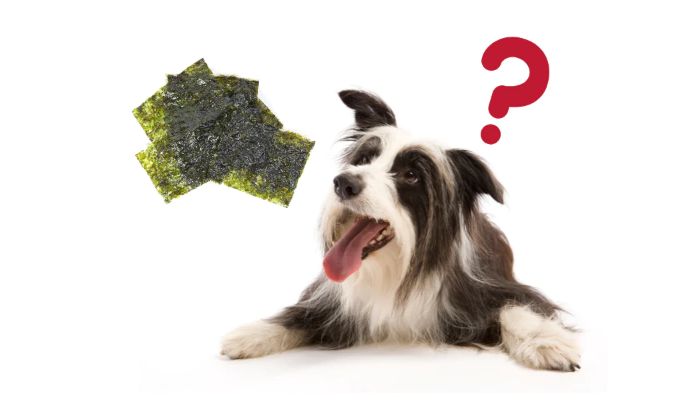Have you ever wondered if feeding seaweed to your pup could provide them with some hidden health benefits? Well, you’re in luck!
In this article, we’ll dive deep into the ocean of knowledge to uncover the positive and negative aspects of adding seaweed to your dog’s diet. From types of seaweed and dosage to side effects and preparation, let’s take a closer look and see if seaweed is really the answer to your pup’s health.
Nutritional Benefits:Advantages of Seaweed for Dogs
You may be surprised to learn that there are numerous benefits to feeding your dog seaweed.
Aside from being rich in essential nutrients, such as iodine, zinc, and iron, seaweed is also a great source of dietary fiber. This makes it a valuable energy source for your pet that helps promote healthy digestion.
Seaweed also contains omega-3 fatty acids, which aid in maintaining your dog’s coat and skin.
Additionally, seaweed is low in calories, making it a great snack option for overweight dogs.
Lastly, seaweed’s antioxidant properties can help support your pet’s immune system.
All in all, seaweed is a nutrient-packed snack with a variety of health benefits for your pup.
Types of Seaweed:

Look into the different types of seaweed available to find the best option for your pup. Seaweed comes in many varieties, and each type has its own unique nutritional profile. Common types of seaweed include kelp, wakame, nori, and dulse. When selecting the best type for your pup, consider the cooking methods used to prepare the seaweed, as well as any potential allergy risks.
Unprepared seaweed can be fed to dogs, but it should be properly cooked to ensure that it’s safe and nutritious. Additionally, cooked seaweed can be added to regular meals to add flavor and nutrition. To reduce the risk of allergic reactions, it’s best to introduce only one type of seaweed at a time.
Benefits of Seaweed for Dogs:
- Nutrient-dense: Seaweed is packed with vital nutrients, including vitamins, minerals, and antioxidants, that can provide health benefits to your pup.
- Variety: From dulse to nori, there are many types of seaweed available to choose from.
- Versatile: Seaweed can be cooked and added to your pup’s regular meals or fed as an occasional treat.
Dosage of Seaweed for Dogs:

Frequently, seaweed can be added to your pup’s regular meals in small amounts to provide beneficial nutrients. However, it’s important to note that seaweed should be included in a pooch’s diet in moderation. Depending on your pup’s dietary restrictions and individual preferences, the amount of seaweed fed to them should be adjusted accordingly.
When introducing seaweed as a food additive to your pup, it’s important to start with small amounts and assess your pup’s reaction. It’s also important to ensure that the seaweed used is safe for consumption, as it may contain harmful toxins if sourced from contaminated waters.
Risks & Considerations: Potential Cautionary Notes
While seaweed can be a beneficial addition to your pup’s diet, it’s important to be aware of any potential side effects it may have. To ensure your pup’s safety, it’s important to not overfeed them seaweed and to be mindful of any digestion issues that may arise. Here are a few key points to consider when adding seaweed to your pup’s diet:
- Monitor your pup’s food intake and ensure that they aren’t overfed
- Keep an eye out for any digestive issues that may arise
- Make sure to consult with a veterinarian if you’re uncertain about adding seaweed to your pup’s diet
Preparation process of Seaweed for Dogs:

Once you’ve determined that seaweed is safe for your pup, preparing it properly is the next step. It’s important to research the various feeding methods and storage options available to ensure you’re providing your pup with the best nutrition possible.
Seaweed can be served fresh, dried, or in a powdered form. Fresh seaweed is usually sold in packages and can be stored in the refrigerator for up to two weeks. Dried seaweed can be purchased in bulk and is best stored in a sealed container in a cool, dry place. Powdered seaweed should also be stored in an airtight container in a cool, dry place and should be used within six months of purchase.
No matter which form of seaweed you choose, make sure to read the manufacturer’s instructions for proper preparation and feeding.
Frequently Asked Questions:
Yes, seaweed can be safe for dogs. Its nutrient content and health benefits can help your pup in many ways. It’s important to know the right type and amount to give, however, to ensure your dog’s safety.
When feeding your dog seaweed, it is important to follow specific feeding guidelines. Seaweed may provide nutritional benefits, but too much can be harmful. Consult your veterinarian for the best feeding amount for your pet.
Comparing different types of seaweed, what nutrients does each provide and what feeding guidelines should be followed? Consider the benefits and drawbacks to ensure your pup is getting the best nutrition.
When feeding your dog seaweed, consider the long-term effects it may have on their health. Alternative sources of nutrition can provide similar health benefits, so consult your veterinarian for the best option for your pet.
To keep seaweed fresh, source it from a trusted supplier and store it in a cool, dry place. Ensure it’s free of contaminants to maximize health benefits for your dog.
Conclusion:
Seaweed can be a beneficial treat for your furry friend – as long as you take the necessary precautions. Consider the type of seaweed, dosage, and side effects before adding it to your pup’s diet.
If done correctly, this superfood can add a healthy boost to your pup’s diet, creating a wave of health and joy that will last for years to come.

Hey there, I’m Janet Brooks, a dog-loving student from California. I’m all about helping pups in need, especially those without homes. Me and my awesome friends work together to give shelter and love to stray dogs. Oh, and I also write blogs about dogs to share helpful info.